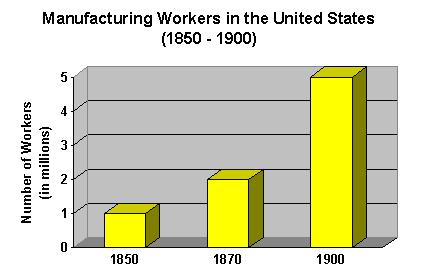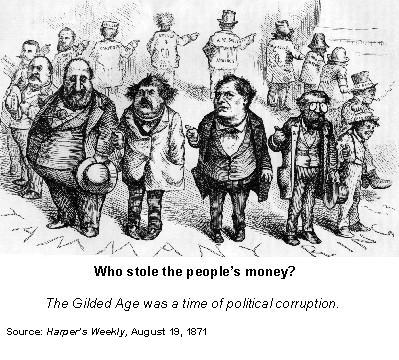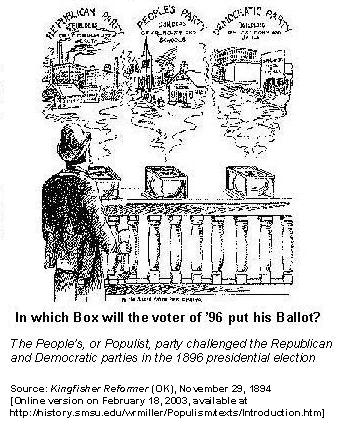INDUSTRIAL AMERICA (1865–1901)
The Railroad
In a country as large as the United States, it is easy to see why fast transportation became increasingly important. In the beginning, Americans relied on horses, wagons, and coaches. As late as 1830, the trip from Boston to New York took two days on a fast stagecoach.
The expanding country desperately needed a quicker and more efficient form of transportation. In the early 1800s Americans dug canals in many of the eastern states. The Erie Canal, completed in 1825, connected the Hudson River to the Great Lakes. This helped New York City, at the mouth of the Hudson, become the largest city in the country.
 In the 1820s George Stephenson had introduced the first successful steam locomotive in England. By 1829, several of his locomotives had been shipped to the United States. The next year the first U.S. railroad began to operate in Charleston, South Carolina.
In the 1820s George Stephenson had introduced the first successful steam locomotive in England. By 1829, several of his locomotives had been shipped to the United States. The next year the first U.S. railroad began to operate in Charleston, South Carolina.
Railroads quickly filled a vital need for travel across the country. By the start of the Civil War in 1861, the country had 30,000 miles of railroad track. But the era of the railroads really began when the Civil War ended.
In the 1860s the Central Pacific Railroad began laying track eastward from Sacramento, California. At the same time, the Union Pacific began building west from Nebraska. The two lines met in Utah in 1869, linking the country by rail from the Atlantic Ocean to the Pacific Ocean. Railroad building continued throughout the 1800s with tracks fanning out in all directions. Eventually, most of the United States was connected by a giant, railroad network.
Railroads had an enormous impact on Americans. Journeys that had taken weeks or months by horses and wagons now took only a few days. People could take trips just about anywhere in the country. But this was minor compared with what railroads meant for industry. Railroads could carry large amounts of raw materials to the factories in the Northeast and the Midwest. They could also carry manufactured items of all sorts to people almost anywhere, even people living in the sparsely-settled West. In these ways, railroads brought jobs, useful goods, and better lives for many people.
All this railroad building cost a lot of money. The federal government helped by giving land grants to private railroad companies. And foreign investors, mostly English, spent billions of dollars.
Back to Top
The Industrial Revolution
In its early years, the United States was an agricultural country. Most people lived on farms. Americans exported agricultural products like cotton and wheat, and they imported most of the manufactured products they used. During the War of 1812, when the supply of such imported goods was cut off, the United States began its first real manufacturing efforts.
Most Americans, however, continued to live and work on farms and in small towns. The Industrial Revolution had begun in England in the late 1700s, but it did not get under way in the United States until after the Civil War. The Industrial Revolution was the change from making goods by hand to making goods with power-driven machines.
 U.S. business leaders built an industrial nation in a very short time. They opened millions of jobs for workers. Many Americans left their farms to become factory or office workers in cities. Thousands of immigrants came from Europe and Asia to work in the new industries and to try to improve their lives.
U.S. business leaders built an industrial nation in a very short time. They opened millions of jobs for workers. Many Americans left their farms to become factory or office workers in cities. Thousands of immigrants came from Europe and Asia to work in the new industries and to try to improve their lives.
On the darker side, businesspeople were often greedy and looked out only for themselves. Poor working conditions, child labor, low wages, long hours, city slums, and frequent economic depressions came with the industrialization period. Business owners, on the other hand, prospered. Some made huge fortunes.
The industrial growth of the United States was rapid. Natural resources such as coal and iron were plentiful. By 1890 the country had replaced England as the world's leading steel producer. It also had more miles of railroad track than any other country in the world.
Back to Top
The Rise of Modern Politics
The Industrial Revolution brought so much wealth to the United States that the writer Mark Twain called the period "the Gilded Age." Most of the wealth from the nation's new industries went to the owners of very large companies. The government and most citizens accepted this order of things. Their idea was that wealthy people would reinvest their wealth by building new factories and opening new markets. More jobs and goods would be available, so everyone would benefit. One hundred years later, President Ronald Reagan's administration built its economic policies on this same idea.
 Seven of the eight presidents during the Gilded Age were Republicans. The one Democrat, Grover Cleveland, placed some restraints on railroads and western land developers. But he, too, accepted the idea that "the business of America is business." In this sense there was really little difference between the two parties.
Seven of the eight presidents during the Gilded Age were Republicans. The one Democrat, Grover Cleveland, placed some restraints on railroads and western land developers. But he, too, accepted the idea that "the business of America is business." In this sense there was really little difference between the two parties.
Cleveland's eight years in office stood out because he ran an honest government. In general, though, the Gilded Age lacked honest politicians-at national, state, and local levels. Even President Ulysses Grant could not control political and financial corruption. Scandal followed scandal during his administration, but the people seemed to accept this as inevitable. They reelected Grant by a large majority.
Most Americans remembered Grant as a war hero. They gave the Republicans credit for winning the Civil War and saving the Union. All seven Republican presidents during the Gilded Age had served in the Civil War.
The Democratic party was strong in the South. Southerners disliked the Republican party because they blamed it for the harsh policies of Reconstruction. The Democratic party had strongholds in large northern cities such as New York, Boston, and Chicago. It also benefited from the great wave of immigration from Europe during the late 1800s, because most immigrants became Democrats.
By the end of the 1800s, some Americans were demanding reforms in government and economic conditions. They started a new political party that appealed to millions of small farmers and city workers. Although no candidates of the new party ever became president, Republicans and Democrats got the message. Republican Theodore Roosevelt became president in 1901. Beginning with his administration, the Gilded Age ended. Strong government reforms, economic change, and different social outlooks pointed the nation in new directions.
Back to Top
Organized Labor
How could working people in the late 1800s improve their situation? Unsympathetic federal and local governments did little or nothing to help them. So workers organized into unions to bargain directly with employers. Then if employers wouldn't listen, the workers could refuse to work and go out on strike.
The first national union, the Knights of Labor, was organized in 1869. It grew to more than 500,000 members, both skilled and unskilled workers. After it led a successful railroad strike, many workers placed their hopes in the union movement.
Then, in 1886, several labor leaders called a mass meeting at Haymarket Square in Chicago. They were demanding reforms such as an eight-hour workday, an end to child labor, and the right to organize unions. The meeting was peaceful until the police arrived to break it up. Someone threw a bomb, and a riot began. To this day no one knows who threw the bomb, yet in the emotional trial that followed the riot, eight labor unionists were convicted of murder. The public generally agreed with the verdict and sided with the police, and the labor movement received a major setback.
Another setback came in 1892 at the Carnegie Steel Company in Homestead, Pennsylvania. Workers went on strike when the company cut their already-low wages. The company hired 300 armed guards to break the strike, and three workers were killed. The governor then sent in 8,000 state troopers. Workers were forced back to their jobs without making any gains.
 The Haymarket riot and the Homestead strike finished the Knights of Labor. However, another national union had entered the scene. This was the American Federation of Labor, which is still functioning after 100 years. It represented only skilled laborers, but the gains it made benefited all workers.
The Haymarket riot and the Homestead strike finished the Knights of Labor. However, another national union had entered the scene. This was the American Federation of Labor, which is still functioning after 100 years. It represented only skilled laborers, but the gains it made benefited all workers.
In 1890 an immigrant from Denmark named Jacob Riis wrote a book entitled How the Other Half Lives. This book described the terrible living conditions of working-class families in New York City slums.
As a young man, Theodore Roosevelt worked for a time with the New York City police. He knew Jacob Riis and was impressed with Riis's book. Later Roosevelt was the first president in 35 years who did not always side with company employers during labor disputes.
Labor unions began to receive kinder treatment from government after Theodore Roosevelt's presidency. In fact, every proposal made by speakers at Haymarket Square in 1886 is now the law.
Back to Top
Changes in Agriculture
While the United States was still mainly an agricultural country, farmers quite naturally had much political influence. With the Industrial Revolution, most of their influence faded away. During this period, farmers fought for more influence in Washington. Often this was a losing cause.
The South continued to cling to an agricultural economy. Plantation owners grew cotton for new U.S. factories in Massachusetts and for older ones in England. Elsewhere, small farmers thrived by supplying food to growing cities.
Farmers in the Midwest and Great Plains states faced the greatest changes. The federal Homestead Act of 1862 offered 160 acres of free land to anyone who would establish a farm on it and stay at least five years. Thousands of people eagerly accepted such a bargain.
Immigrants from Sweden, Norway, and other Northern European countries flocked to the central and western farming regions. Immigrants from southern and central Europe usually took jobs in cities.
 New farming equipment from the new factories helped western farmers produce more than ever before. They shipped many of their products to Europe. New refrigeration ships made it possible to send dairy and meat products over long distances. Wheat, however, was their chief export. Farmers saw good times and bad times until 1884. After that year, farm prices dropped steadily, and many farmers could barely make a living. A long drought hurt them even more.
New farming equipment from the new factories helped western farmers produce more than ever before. They shipped many of their products to Europe. New refrigeration ships made it possible to send dairy and meat products over long distances. Wheat, however, was their chief export. Farmers saw good times and bad times until 1884. After that year, farm prices dropped steadily, and many farmers could barely make a living. A long drought hurt them even more.
Like factory and railroad workers, farmers united in a national organization to make themselves heard in the state capitals and in Washington. This organization was called the Grange. It considered the railroads to be the farmers' chief enemy. Railroads often charged farmers extremely high prices for carrying their produce. The Grange sometimes succeeded in getting these prices reduced.
The Grange united farmers and stirred their interest in politics. Farmers everywhere were tired of being ignored by Republicans and Democrats alike. In 1892 they joined with labor groups to form the People's party. Its platform stated, "The fruits of the toil of millions are boldly stolen to build up colossal fortunes for a few." The People's party ran its own candidate for president in 1892 and supported the Democratic candidate in 1896.
Followers of the People's party were called Populists. They announced their support of "the little man" against "big business." Their party had a short life, but it was a strong force in the reforms that Republicans and Democrats both began to support. Farmers as well as workers' unions gained under these reforms during the early 1900s.
Back to Top Seven of the eight presidents during the Gilded Age were Republicans. The one Democrat, Grover Cleveland, placed some restraints on railroads and western land developers. But he, too, accepted the idea that "the business of America is business." In this sense there was really little difference between the two parties.
Seven of the eight presidents during the Gilded Age were Republicans. The one Democrat, Grover Cleveland, placed some restraints on railroads and western land developers. But he, too, accepted the idea that "the business of America is business." In this sense there was really little difference between the two parties. In the 1820s George Stephenson had introduced the first successful steam locomotive in England. By 1829, several of his locomotives had been shipped to the United States. The next year the first U.S. railroad began to operate in Charleston, South Carolina.
In the 1820s George Stephenson had introduced the first successful steam locomotive in England. By 1829, several of his locomotives had been shipped to the United States. The next year the first U.S. railroad began to operate in Charleston, South Carolina.
 U.S. business leaders built an industrial nation in a very short time. They opened millions of jobs for workers. Many Americans left their farms to become factory or office workers in cities. Thousands of immigrants came from Europe and Asia to work in the new industries and to try to improve their lives.
U.S. business leaders built an industrial nation in a very short time. They opened millions of jobs for workers. Many Americans left their farms to become factory or office workers in cities. Thousands of immigrants came from Europe and Asia to work in the new industries and to try to improve their lives.
 The Haymarket riot and the Homestead strike finished the Knights of Labor. However, another national union had entered the scene. This was the American Federation of Labor, which is still functioning after 100 years. It represented only skilled laborers, but the gains it made benefited all workers.
The Haymarket riot and the Homestead strike finished the Knights of Labor. However, another national union had entered the scene. This was the American Federation of Labor, which is still functioning after 100 years. It represented only skilled laborers, but the gains it made benefited all workers.
 New farming equipment from the new factories helped western farmers produce more than ever before. They shipped many of their products to Europe. New refrigeration ships made it possible to send dairy and meat products over long distances. Wheat, however, was their chief export. Farmers saw good times and bad times until 1884. After that year, farm prices dropped steadily, and many farmers could barely make a living. A long drought hurt them even more.
New farming equipment from the new factories helped western farmers produce more than ever before. They shipped many of their products to Europe. New refrigeration ships made it possible to send dairy and meat products over long distances. Wheat, however, was their chief export. Farmers saw good times and bad times until 1884. After that year, farm prices dropped steadily, and many farmers could barely make a living. A long drought hurt them even more.